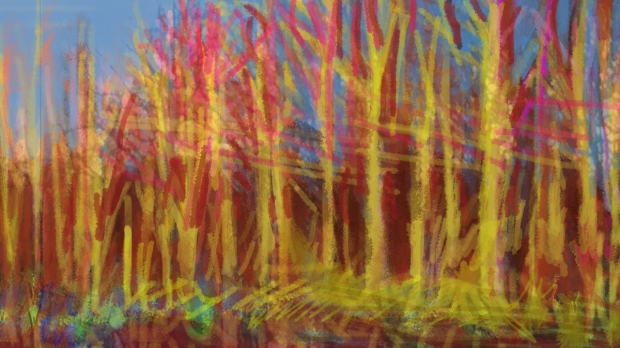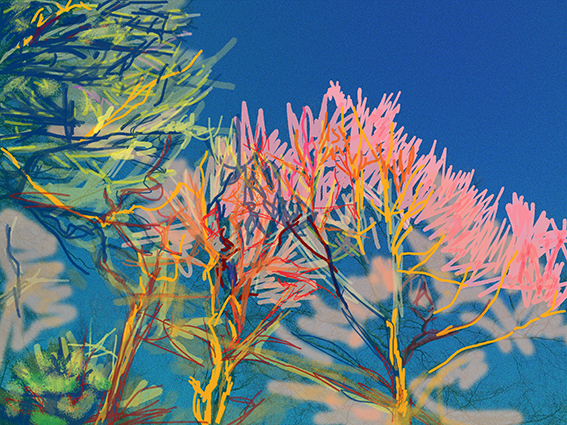Sketching with watercolour pencils and using the camera on your phone to record your observations.
This vlog is about my artistic endeavours.
I called it ‘Sketchbook Journey’ because my sketchbook would always accompany me when going out, whether out with the dogs in a park, waiting for son at the school or generally going somewhere – you never know what would you observe, in my case, I would always notice something amazing out there…
I’m writing this blog and recording this vlog so to help you understand the ways to perceive the nature and importance of such observations.
I am pointing at the challenges which you may encounter when creating a piece of art and the ways of recording observations of the world using different media such as watercolour pencils or photo editing apps on your phone.
Stage 1: OBSERVATION
What I saw when observing trees in the park.
I was observing the trees in the park and this is what I saw:

The light from the setting sun illuminated the tree trunks, tinted them yellow. The branches were bright like neons, contrasting with the grey-blue sky. In the background, everything became red, pink and orange.

Learn from observing nature.
We can really learn from observing nature. Observing and sketching it live, rushing, as it changes so quickly. This forces us to make quick, bold decisions, focus only on important aspects of your drawing such as the appearance of light and how does it affect the colour.

Stage 2: Recording observations
Watercolour pencils
The watercolour pencils are great for sketches. They can be used like ordinary pencils with a bonus that gives us a quick colour reference.

This is a perfect opportunity to practice mark-making. You can smoodge and overlap strokes, blend colours together. And with a sharp pencil tip, we can use them to define fine lines, details and shapes. Add a bit of water, your drawing will transform into a watercolour painting right before your eyes!

The page in my sketchbook was tinted light blue and coated with Liquitex gesso. The gesso gives the surface a bit of a rough, grainy texture, making the watercolour pencil’s inner lead to rub away and leaving on the paper vibrant, smooth marks

The aim of my sketch
The aim of my sketch was to register the contrast in the sky – reversed light and order of colours. Normally, we see the sky brighter than the rest of the world. Here, the trunks of the trees shine yellow light like neons on a murky blue sky. The branches shine red, like firey tongs, exploding in different directions.

Taking photos and editing them on your phone
I would mostly take a photo rather than a sketch. The good thing about technology is that we can enhance our photos on our phones with a variety of photo apps.

Here, on my iPhone, I was playing with the camera’s setting for:
- colour saturation
- brightness & contrast,
- colour filters,
- and markup drawing.

The markup drawing function is so useful because you can draw over your photograph, easily changing the colours as you wish, trying various colour schemes.
However, be careful and make sure you save it! It happened to me a few times that I spent an hour drawing on a photo but didn’t save the photo and after all everything was lost.
COLOUR THEORY
Complementary colours
The yellow and blue, orange and blue, purple and yellow – these are complementary colours, they sit opposite each other on a colour wheel.
The colour theory states that the more different two colours are, the more contrast they produce. Complementary colours offer the greatest contrast.

Just like on this sketch: here the branches are orange which contrasts against the very blue sky. Orange colour is, in fact, a half red colour. It derives from red and yellow… So the stomp branches are red, dark red and contrast with its complementary green. My sky transforms from light-blueish green, well – turquoise (…can you imagine such colour?! :D), into light cyan blue.

YOUR TASK
I would like you to take a few sketches using watercolour pencils or just standard pencils if you cannot get hold of them.
Your sketch should show:
– Various mark making – showing the texture or nature of objects.
– Complementary colour palette:
For the main body of your drawing choose only the colours between two complementary colours, including them eg:
Say you chose red and yellow so choose also their secondary colour – orange and the variety of their tertiary colours and their different hues (yellow-orange, reddish orange, orangy yellow – which is an orange colour more yellow than orange…)
Choose a complementary to this range of colours for the background so, in this case: blue, bluish green and green.
Post your results on to my Facebook page or email me with a subject: ‘My sketches of nature’. I will talk and post your achievement on my social media accounts.
Want to see more?
So, this was the first of my many sketchbook journeys.
I would like to know what you think?
Whether you have any questions or would like to give feedback, please, leave a comment below.
I would also appreciate if you can subscribe to my YouTube channel.
Thank you for watching and thank you for reading. See you on my next sketchbook journey…


Leave a comment